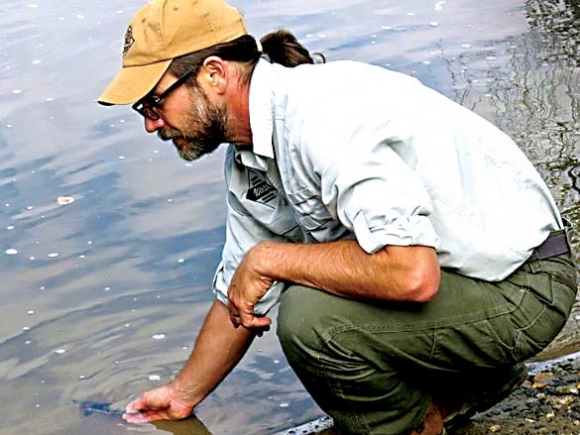Welcome home

The lake sturgeon, Acipenser fulvescens, once ranged across North America from the Great Lakes and Hudson Bay drainages down the Mississippi to Louisiana and from the east coast to Wisconsin. But this prehistoric creature (sturgeons date back 135 million years) has had a tough go of it for the last 100 years or so. The dam building craze of the 20th Century often blocked access to the sturgeons’ natal (river or area where they hatched) spawning grounds.
Some lake sturgeons migrate more than 100 miles upstream to spawn. Loss of spawning and feeding habitat plus degradation of water quality due to large-scale deforestation and unfettered industrial pollution coupled with over-fishing exacerbated the situation. Today the lake sturgeon is considered threatened or endangered in 19 of the 20 states within its range.
The last anecdotal record from Western North Carolina is from the French Broad River near Hot Springs in the mid 1940s. Today, thanks to collaboration among the U.S. Fish and Wildlife Service, Tennessee Aquarium Research Institute, Tennessee Wildlife Resource Agency, Tennessee Valley Authority, North Carolina Wildlife Resources and others, lake sturgeons are once again splashing in the French Broad.
According to Steve Fraley, Western Aquatic Wildlife Diversity Coordinator, Division of Inland Fisheries at NCWRC, the reintroduction of lake sturgeon to the region began back in the late 1990s when U.S. Fish & Wildlife and the Tennessee Aquarium began to experiment with captive culture.
Fraley said NCWRC became interested in the project in the early 2000s and that he began discussions with primary partners around 2006. At that time, Warm Springs National Fish Hatchery in Georgia was the only source for captive culture and there were no fish to spare to expand the effort. But in the late 2000s, the National Fish Hatchery in Edenton, North Carolina joined the effort making more fish available and in 2013 NCWRC became involved.
Fraley said there were a number of reasons the agency wanted to become involved. He noted that restoration of native wildlife was a fundamental objective of NCWRC plus, “Lake sturgeon are considered to be an important part of the big river ecosystem that was missing, as well as a large potentially popular sport and food fish, as well as potentially sustaining a commercial harvest at some point.”
Related Items
And, according to Fraley it didn’t hurt that the sturgeon, “…are also just flat out cool and charismatic and people really like them and supported the effort.”
He said that nearly 16,000 sturgeon have been released in the French Broad near Hot Springs since 2015. Fraley said that because the lake sturgeon is such a long-lived fish (some females may live for 150 years) and can take up to 15 – 20 years to sexually mature, “…the objective is to stock them annually until we see evidence of gravidity [females with eggs] and spawning, then back off and assess how well they reproduce and recruit wild-spawned fish into the population. That is, at least 15-20 years.”
Fraley said NCWRC will use a variety of methods including electrofishing, gill nets, baited trot lines and implanted radio transmitters to monitor the fish and that success will be measured by, “…the presence of mature adults and evidence of recruitment of wild-spawned fish into the population and hopefully, a self-sustaining population that could support a sustainable harvestable fishery.”
If NCWRC and partners are successful, when dinosaurs roamed the earth could be now.
Don Hendershot is a writer and naturalist. He can be reached a This email address is being protected from spambots. You need JavaScript enabled to view it..









